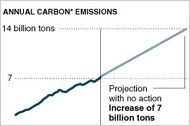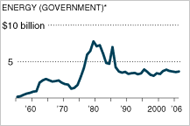DENVER — Cheers fit for a revival meeting swept a hotel ballroom as 1,800 entrepreneurs and experts watched a PowerPoint presentation of the most promising technologies for limiting global warming: solar power, wind, ethanol and other farmed fuels, energy-efficient buildings and fuel-sipping cars.
The Energy Challenge
The Research ShortageArticles in this series are examining the ways in which the world is, and is not, moving toward a more energy efficient, environmentally benign future.
Previous Articles in the Series »“Houston,” Charles F. Kutscher, chairman of the Solar 2006 conference, concluded in a twist on the line from the movie “Apollo 13,” “we have a solution.”
Hold the applause. For all the enthusiasm about alternatives to coal and oil, the challenge of limiting emissions of carbon dioxide, which traps heat, will be immense in a world likely to add 2.5 billion people by midcentury, a host of other experts say. Moreover, most of those people will live in countries like China and India, which are just beginning to enjoy an electrified, air-conditioned mobile society.
The challenge is all the more daunting because research into energy technologies by both government and industry has not been rising, but rather falling.
In the United States, annual federal spending for all energy research and development — not just the research aimed at climate-friendly technologies — is less than half what it was a quarter-century ago. It has sunk to $3 billion a year in the current budget from an inflation-adjusted peak of $7.7 billion in 1979, according to several different studies.
Britain, for one, has sounded a loud alarm about the need for prompt action on the climate issue, including more research. [A report commissioned by the British government and scheduled to be released today calls for spending to be doubled worldwide on research into low-carbon technologies; without it, the report says, coastal flooding and a shortage of drinking water could turn 200 million people into refugees.]
President Bush has sought an increase to $4.2 billion for 2007, but that would still be a small fraction of what most climate and energy experts say would be needed.
Federal spending on medical research, by contrast, has nearly quadrupled, to $28 billion annually, since 1979. Military research has increased 260 percent, and at more than $75 billion a year is 20 times the amount spent on energy research.
Internationally, government energy research trends are little different from those in the United States. Japan is the only economic power that increased research spending in recent decades, with growth focused on efficiency and solar technology, according to the International Energy Agency.
In the private sector, studies show that energy companies have a long tradition of eschewing long-term technology quests because of the lack of short-term payoffs.
Still, more than four dozen scientists, economists, engineers and entrepreneurs interviewed by The New York Times said that unless the search for abundant non-polluting energy sources and systems became far more aggressive, the world would probably face dangerous warming and international strife as nations with growing energy demands compete for increasingly inadequate resources.
Most of these experts also say existing energy alternatives and improvements in energy efficiency are simply not enough.
“We cannot come close to stabilizing temperatures” unless humans, by the end of the century, stop adding more CO2 to the atmosphere than it can absorb, said W. David Montgomery of Charles River Associates, a consulting group, “and that will be an economic impossibility without a major R.& D. investment.”
A sustained push is needed not just to refine, test and deploy known low-carbon technologies, but also to find “energy technologies that don’t have a name yet,” said James A. Edmonds, a chief scientist at the Joint Global Change Research Institute of the University of Maryland and the Energy Department.
At the same time, many energy experts and economists agree on another daunting point: To make any resulting “alternative” energy options the new norm will require attaching a significant cost to the carbon emissions from coal, oil and gas.
“A price incentive stirs people to look at a thousand different things,’ ” said Henry D. Jacoby, a climate and energy expert at the Massachusetts Institute of Technology.
For now, a carbon cap or tax is opposed by President Bush, most American lawmakers and many industries. And there are scant signs of consensus on a long-term successor to the Kyoto Protocol, the first treaty obligating participating industrial countries to cut warming emissions. (The United States has not ratified the pact.)
The next round of talks on Kyoto and an underlying voluntary treaty will take place next month in Nairobi, Kenya.
Environmental campaigners, focused on promptly establishing binding limits on emissions of heat-trapping gases, have tended to play down the need for big investments seeking energy breakthroughs. At the end of “An Inconvenient Truth,” former Vice President Al Gore’s documentary film on climate change, he concluded: “We already know everything we need to know to effectively address this problem.”
While applauding Mr. Gore’s enthusiasm, many energy experts said this stance was counterproductive because there was no way, given global growth in energy demand, that existing technology could avert a doubling or more of atmospheric concentrations of carbon dioxide in this century.
Mr. Gore has since adjusted his stance, saying existing technology is sufficient to start on the path to a stable climate.
Other researchers say the chances of success are so low, unless something breaks the societal impasse, that any technology quest should also include work on increasing the resilience to climate extremes — through actions like developing more drought-tolerant crops — as well as last-ditch climate fixes, like testing ways to block some incoming sunlight to counter warming.
















